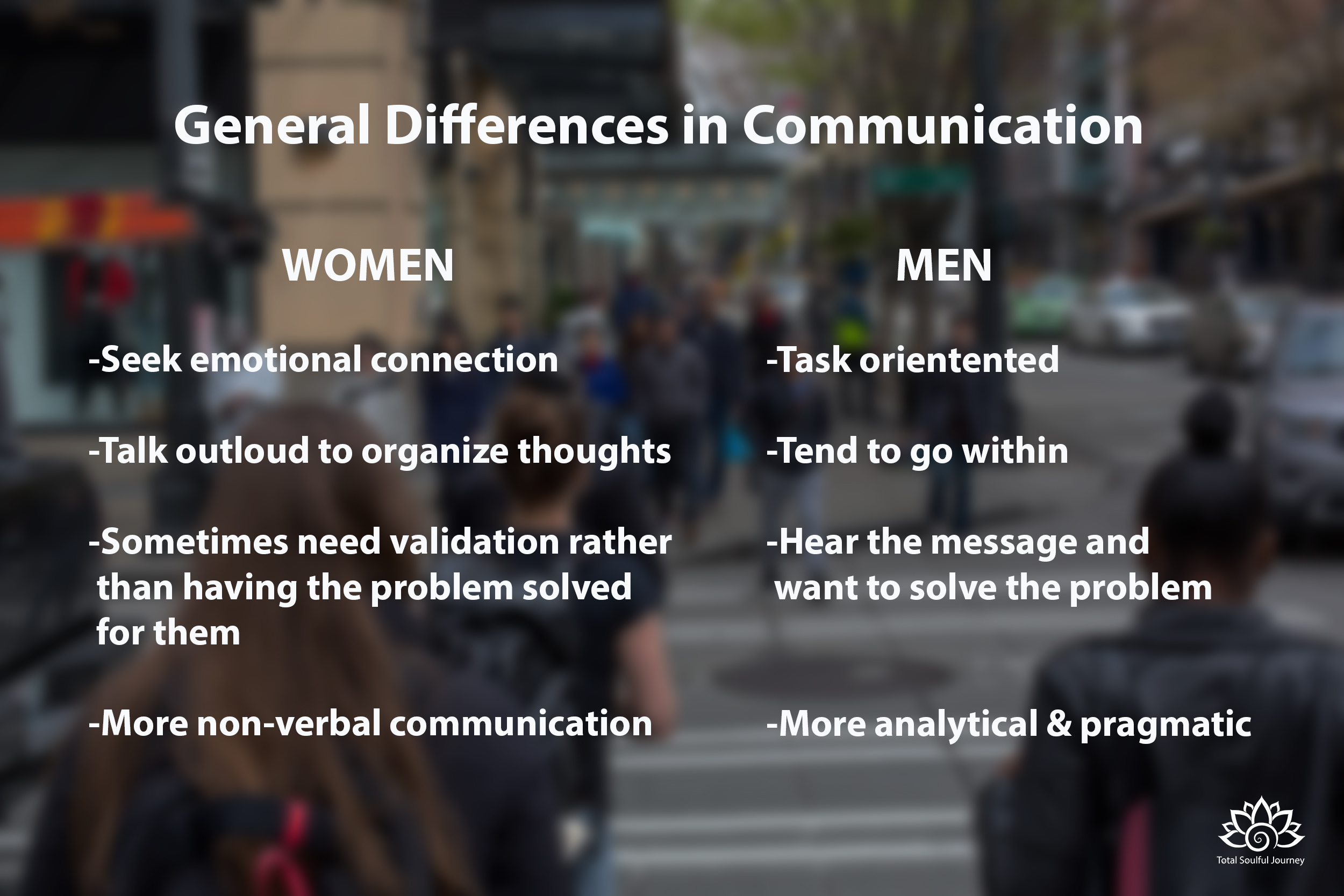Communication: Male vs. Female
/Our Differences are More Minor than You May Think
There are subtleties in the language men vs women use in comunicating with one another. But it is not as divergent as in “men are from mars and women are from venus.” We are actually more similar than you might think. Communication includes words spoken, tone, posture, micro-gestures and the ability to listen. Men and women possess both male and female qualities (read about them in our last post), which allow us to connect on a deeper level. We all can be nurturing, sentimental, and also aggressive. Sometimes it is not the words spoken, but instead how we translate what is said to us that creates our reactions. By understanding our different communication styles, we can have healthier relationships.
We may be wired differently, but if we are aware of those differences it can change our ability to understand one another. Ultimately we desire to satisfy each other, however, it is sometimes difficult as our egos can easily feel resentment. When men and women effectively express their desires to one another, you can see their body language relax because ultimately they both want peace, happiness and solutions to conflict.
Watch this interesting video to understand the subtleties in communication between men and women.
He Says/She Says
Understanding is half the battle and it aliviates getting our feelings hurt unnecessarily. Here are a few examples of how men and women misinterpret one another:
- He says: "I am really tired. I have a ton of work to do so I cannot hang out tonight."
She says: "What? You don’t want to spend time with me?"
He says: "There you go again. I am never enough."
- Can you see that both egos are bruised here. The guy simply had to work, but she let her emotions go and took it personally.
2. She says: "I am really tired. I have so much work to do so I cannot hang out tonight."
He says: "Why don’t you take a night off and relax. I will take you to dinner."
She says: "Thanks a lot (sarcastically)! Clearly you do not value the work I do."
- This is an example of a task driven woman and a man who wants to problem solve. Sometimes we simply need to listen without trying to fix anything.
3. She says: "Call me, or text when you get there so I know you're safe."
He says: "What you don’t trust me?"
She says: "Fine, nevermind..."
- Here she loves and cares about him and wants to be sure he is safe driving at night or in bad weather. He, on the other hand, feels like she does not trust him and that she is being overbearing.
We hope that you appreciate the humor and the lesson in this video.
The 5 Love Languages
We each have a dominant love language. What does that mean? Well, when our significant other understands our “love language” they will comminucate in a style that we best respond to.
The five love languages as explained in the book, "The Five Love Languages", by Gary Chapman are:
- Words of affirmation (compliments)
- Quality time and conversations
- Receiving gifts
- Acts of Service
- Physical touch
I highly reccomend this book to everyone even if you are not in a relationship. It helps you understand yourself better. I, for example, value quality time and conversations with my loved one. I am less likely to give my partner physical touch, acts of service (such as doing his laundry), compliment him, or give him gifts when my inherent needs of quality time and conversation are not being met. By communicating this to my partner, he becomes aware of my needs and what I value most. You should also understand your partner's love language so that you can also meet his or her needs. This is very important, because we tend to do for our partner what we value most for oursel. However, to have a healthy relationship we should love them according to their love language.
Photography by Libby McAvoy
Remember that words can be forgiven, but never forgotten. Words are very powerful. You can lift someone up or you can crush their soul by what you say to another person. Body language is also important. Try to keep your arms uncrossed when having a serious conversation so that the person you are talking with finds you more relaxed, receptive and open minded. Finally, eye contact is also an important part of non-verbal communication. Look into the person’s eyes that you are speaking with. Maybe nod your head so they know that you are listening and do not misinterpret a nod for meaning they agree so much as they are also listening attentively.
Many arguments can be avoided or overcome by simply learning how to respectfully and compassionately communicate. Speak with loving kindness and listen to hear and understand rather than respond or fix anything. If you disagree, consider saying, “I hear what you are saying, but I need time to process how I feel about that.” OR “ I hear what you are saying.” Also, try not to bring up a heated conversation when you are with other people. It is best to have serious conversations while taking a walk together or spending time at home.
With love and clarity,
Libby McAvoy
P.S. - On Tuesday, Paul will continue this short series, which relates to awareness, communication and understanding. Thanks for reading and supporting this post. If you learned from it be sure to hit the "Likes" button below. This helps us know if we are providing helpful and interesting content to you. Have a wonderful weekend!
Awaken • Inspire • Empower
New Posts Every Tuesday and Saturday





